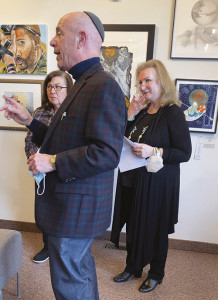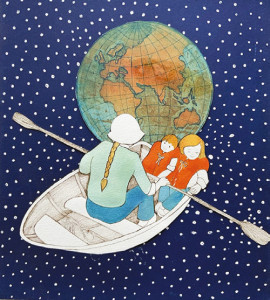
Art is often about challenging people to get out of their comfort zones and acknowledge unpleasant truths, or open themselves up to a new point of view. The exhibit, “Hope Out of the Darkness: An Artistic Interpretation,” now at the Belskie Museum in Closter, New Jersey does the opposite. It is a refreshing paean to optimism after three years of isolation and fear from the pandemic. The art in a variety of media—oils, watercolors, collage and sculpture—visually strokes viewers and tells them to take a deep breath; everything will be alright.
In the juried show, 48 artists had their work accepted for submission. The exhibit was organized by artists Sheryl Intrator Urman of Englewood, New Jersey and Fred Spinowitz of New Rochelle, New York, who curated art exhibits at the Belskie for seven years until the pandemic. This year, Abigail Meyer, curator of the Jewish antiquity department of the Metropolitan Museum of Art in New York City, joined as a curator and juror. Anita Duquette, a member of the Belskie board of directors and former archivist for the Whitney Museum in New York City, has been a juror with Urman and Spinowitz for all their exhibits at the Belskie Museum.
When Donald Farell, president of the Belskie Museum, asked Urman and Spinowitz if they wanted to curate an in-person exhibit this year, both thought long and hard about whether they were ready for such a major public project. But there was one really good reason to say yes. Urman and Spinowitz love creating art, teaching art, and bringing together talented artists to share their work with viewers. “Having the opportunity to do a show and hold a reception felt like a coming out party,” said Urman. “Speaking to friends, relatives, even children, so many felt like this has been an isolating, reclusive time. And the word that came to me was hope—hope that we were returning to normal and could be with people again. It’s a global feeling that artists can relate to, and viewers can relate to.”
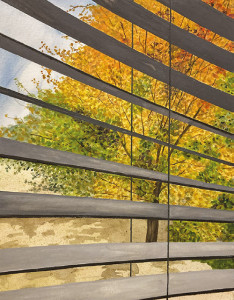
Urman and Spinowitz have been organizing exhibits together for over 10 years. Their first exhibits were through the Jewish Federation’s Artists Partnership Together program, which Urman chaired. When that ended they continued on their own. Their exhibits always have a theme that comes from Tehillim or Tanach. “Hope Out of the Darkness” is inspired by Tehillim 46:3: “Therefore we will not fear when the earth changes and when the mountains totter into the sea.”
The artists must submit a written statement about how their work connects to the theme.
The art has universal appeal, but some is unabashedly Jewish. Yitzchak Moulley is a Chabad rabbi who discovered he had artistic abilities and could create art, which was another way of impacting the world. He has been painting since 2006 and has been a full-time artist since 2015. For this exhibit, he submitted a painting of three doves, representing the two Batei Hamikdash that were destroyed and the third one not yet in existence. “We are yearning and hoping for the third temple,” he said. The painting is very peaceful with an idyllic blue sky. He decided, though, that it didn’t reflect the history of Jews waiting and suffering. So he went in search of barbed wire and surrounded the painting with it. “The Rambam said that every day we have to wait, we ask will today be the day we bring Moshiach. We wait but recognize the heaviness and destructiveness of life as we know it.”
There is one painting I keep thinking about of an Israeli soldier wearing tefillin, looking out from the painting with one eye, the tefillin giving him hope as he confronts his fears. It was painted by Yael Rachel Smith, who has only been painting for a few years but is becoming very successful. Some artists chose to create work about their own personal difficulties and the hope that their troubles are ending. Joel Silverstein, an artist who curates exhibits for the Jewish Art Salon in New York City, painted a self-portrait to express gratitude that recent surgery was successful and he is now able to paint again.
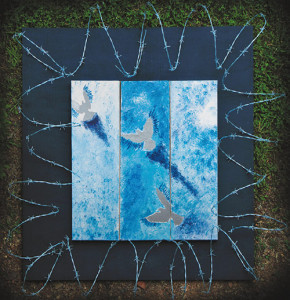
The jurors chose first, second, and third place winners, and an honorable mention. Urman said they spent hours reviewing the merits of each submission until they finally agreed on the choices. First place went to a bronze sculpture titled “Possibilities” by Catherine Schmitt. In the sculpture, a woman stands at the top of the stairs, contemplating a yellow land full of promises. Second place went to “The Crossing” by Kristy Gordon, a Canadian born artist living in New York. Her triptych painting “moves from existential darkness on the left, to spiritual light on the right, with the center panel depicting both the struggle and the surrender of attempts to ‘tame the beast’ as one moves through a transition.” Third place went to New York artist Barbara Swanson Sherman for “Motherhood,” a collage of two etchings and a pen and ink drawing showing a mother and two children in a rowboat sailing in a mystical sea around the globe. In a conversation we had, she said, “Motherhood is an act of hope—you’re totally responsible, and totally at sea.” Honorable mention went to “Blinded by the Foliage,” a watercolor by Livingston, New Jersey artist Laura Siegel, with perhaps the most relatable premise. She wrote: “For several months I felt like a prisoner in my home during the COVID-19 pandemic. I was anxious, socially isolated and afraid to be among people. Looking out from my windows, seeing the changes in the seasons and the weather, reminded me that life goes on and there was hope for the future.”
Duquette said the show is unusual in that all the work has a strong emotional aspect that reflects what the artists were living through for the past three years. “I have seen little kids walk in here and gravitate to one or two pieces,” she said. “This morning I saw a family of four. The grandfather said, ‘this is the best show.’ Even the teenager said, ‘I like this one and I like that one.’ This is a show that resonates with the general public. It’s not snobby, ‘only-in-the-know’ art.”
Bringing artists together to share art with viewers is one of Spinowitz’s passions. He has a particular interest in infusing art with Jewish themes. He works in a variety of materials and embeds Hebrew calligraphy in all his work. Trained as a classical artist, he said much of what he learned was from art created from or for churches. Now he wants to “return the favor” and show both the richness of Judaism and the beauty of art. People often ask him to translate the calligraphy. He tells them he could but suggests they look closely at the work and see if they can interpret it without any knowledge of Hebrew. They usually do.
In addition to curating art exhibits, Urman has led tours through the Metropolitan Museum of Art and lectures about art for adult groups including Dor L’Dor at Englewood’s Congregation Ahavath Torah. She taught art to children after school and in summer camps for many years through her business Art for Learning. Today she is concentrating on creating and selling art through her website, www.sherylintrator.com.
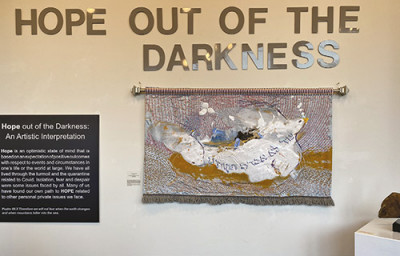
The Belskie Museum, located at 280 High Street in Closter, was built by the Lions Club of Closter to preserve and exhibit the work of local artist Abram Belskie and donated to the Borough of Closter as a tax-exempt nonprofit run by volunteers. “Hope Out of the Darkness” will be at the Belskie Museum through Feb. 26.
By Bracha Schwartz
